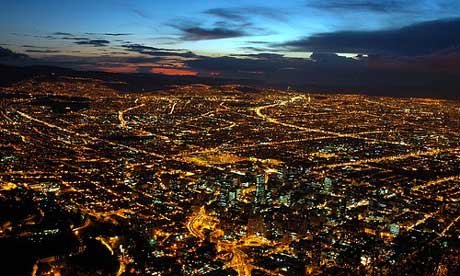
After winning our 2010 Travel Awards for Emerging Destination, Colombia is getting back to winning ways with colonial gems, lost cities and untrodden beaches
Few countries boast such striking physical variety as Colombia, a nation geographically complex and physically vast, encompassing Pacific and Caribbean coasts, lofty Andean highlands, sweaty jungle lowlands, fertile plains and cacti-clad desert. Yet, thanks to a murky past, it’s only now rearing its head on the traveller trail.
In the country’s east lie the Andes, full of pre-Columbian history and bird-rich forested highlands. Rolling savannahs and cattle-strewn grasslands characterise the central region, while to the south-west you’ll find the silvery sands of the Pacific shore, highway for migratory whales. On the Caribbean Coast, palm-scattered, golden beaches meet some of the finest colonial cities in the Americas, including Unesco-protected Cartagena – the true jewel in a treasure trove of Spanish ostentation, where slavery, sainthood and swashbuckling buccaneers have each played their part.
In the south-east the Amazon Basin covers almost one-third of Colombia’s territory, merging into neighbouring Peru and Brazil. The jungle here has escaped large-scale deforestation and is mostly unexplored, still home to numerous indigenous communities in teetering mud-and-thatched settlements as well as vast numbers of animals, plants and birds.
Nature isn’t restricted to the Amazon, however; Colombia has almost 60 designated national parks and protected areas. Plus the country is doing a flourishing world trade in cut flowers – a velvety tonnage, found everywhere from M&S to Walmart, that thrives on Colombia’s year-round long equatorial days without a need for super-heated, expensive greenhouses.
Yet, despite these great natural facets, Colombia has been overlooked in tourism terms for decades. Once synonymous with coca fields, violent crime and kidnappings, South America’s black sheep – having worked hard to transform global perceptions – is now reaping the rewards. Colombia now has fewer kidnappings than Mexico, India, South Africa and Brazil, and is expecting 2.8 million visitors in 2010 – not bad for a country once labelled ‘the most dangerous on the planet’.
Improved security and widespread infrastructure investment under the administration of hard-liner President Uribe have opened up overland routes while several thousand guerrillas and paramilitaries have laid down their arms. Today, a welcoming population with big, friendly smiles typifies Colombia. It is not uncommon for foreign visitors to be greeted with ecstatic celebrations in rural outposts – genuine warmth far removed from the primitive depiction of Colombia we see in the headlines.
To visit Colombia in this, a new era, you’re in a privileged position: this is a nation largely undisturbed yet willing to expose its inner reaches where unique, rustic and glorious Colombian quirks have yet to be ironed-out by super-slick tourism machines – for the time being, at least.
San Andrés Archipelago: Located 800km north-west of the mainland, this remote archipelago is home to islets, cays, a Biosphere Reserve and profuse marine life
Cartagena: This fine colonial city boasts exquisite architecture, with an old core of balconied buildings ringed by thick stone walls and embedded dungeons
La Guajira: Colombia’s northernmost tip remains distinctly different, from its guttural language to the dry, arid deserts that dominate the peninsula
Villa de Leyva: Declared a national monument in 1954, this small town of whitewashed, green-shuttered houses is a triumph of architectural conservation
Los Llanos (The Plains): Colombia’s cowboy country is characterised by undulating grasslands, ranches and vast herds of cows, and set to the rhythm of folksy Llanero ballads
San Agustín: The Parque Arqueológico at San Agustín is shrouded in mystery: a bewildering array of fine, carved monumental stones dating from the second century BC, still perfectly intact
The Amazon: Rapids and waterfalls characterise Colombia’s undisturbed lowland jungle, home to hundreds of indigenous communities and outstanding biodiversity
If Colombia's tickled your fancy, check out these great itinerary ideas:
From Caribbean charm to the Lost City – Cartegena & the north (two weeks)
Mix urban sights with golden lakes and coffee plantations – Bogotá and around (two days – two weeks)
Meet ancient civilisations – The south (two weeks)
Cross-border connections from neighbouring nations – Colombia in context (as much time as you've got!)